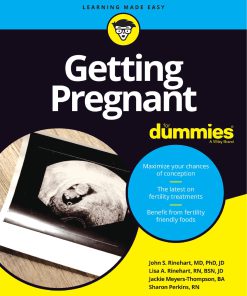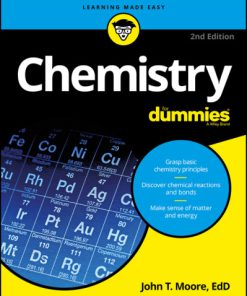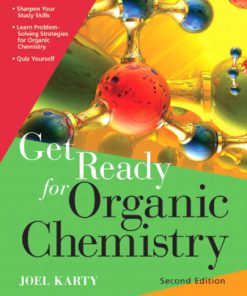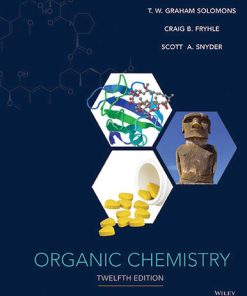Organic Chemistry II For Dummies 2nd edition by John Moore, Richard Langley 1119985198 9781119985198
$50.00 Original price was: $50.00.$25.00Current price is: $25.00.
Organic Chemistry II For Dummies 2nd edition by John T. Moore, Richard H. Langley – Ebook PDF Instant Download/DeliveryISBN: 1119985198, 9781119985198
Full download Organic Chemistry II For Dummies 2nd edition after payment.
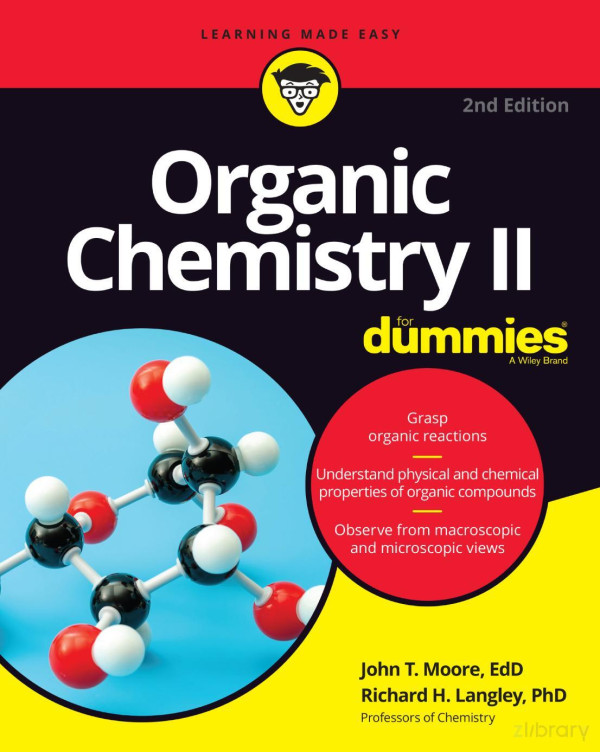
Product details:
ISBN-10 : 1119985198
ISBN-13 : 9781119985198
Author: John T. Moore, Richard H. Langley
Organic chemistry is, well, tough. With Organic Chemistry II For Dummies, you can (and will!) succeed at one of the most difficult college courses you’ll encounter. We make the subject less daunting in the second semester, with a helpful review of what you learned in Organic Chemistry I, clear descriptions of organic reactions, hints for working with synthesis and roadmaps, and beyond. You’ll love the straightforward, effective way we explain advanced O-chem material. This updated edition is packed with new practice problems, fresh examples, and updated exercises to help you learn quickly. Observe from a macroscopic and microscopic view, understand the properties of organic compounds, get an overview of carbonyl group basics, and everything else you’ll need to pass the class. Organic Chemistry II For Dummies is packed with tips to help you boost your exam scores, stay on track with assignments, and navigate advanced topics with confidence.
Organic Chemistry II For Dummies 2nd Table of contents:
Part 1: Brushing Up on Important Organic Chemistry I Concepts
Chapter 1: Organic Chemistry II: Here We Go Again!
Recapping Organic Chemistry I
Looking Ahead to Organic Chemistry II
Chapter 2: Remembering How We Do It: Mechanisms
Duck — Here Come the Arrows
Coming Around to Curved Arrows
Getting Ready for Some Basic Moves
Combining the Basic Moves
Revisiting Free-Radical Mechanisms
Chapter 3: Alcohols and Ethers: Not Just for Drinking and Sleeping
Getting Acquainted with Alcohols
Introducing Ether (Not the Ether Bunny)
Summarizing the Spectra of Alcohols and Ethers
Chapter 4: Conjugated Unsaturated Systems
When You Don’t Have Enough: Unsaturated Systems
Delocalization and Resonance
Reactions of Conjugated Unsaturated Systems
Passing an Exam with Diels-Adler Questions
Chapter 5: “Seeing” Molecules: Spectroscopy Revisited
Chemical Fingerprints: Infrared Spectroscopy
Suntans and Beyond: Ultraviolet and Visible Spectroscopy
Not Weight Watchers, Mass Watchers: Mass Spectroscopy
No Glowing Here: NMR Spectroscopy
Part 2: Discovering Aromatic (And Not So Aromatic) Compounds
Chapter 6: Introducing Aromatics
Benzene: Where It All Starts
Smelly Relatives: The Aromatic Family
Black Sheep of the Family: Heterocyclic Aromatic Compounds
Spectroscopy of Aromatic Compounds
Chapter 7: Aromatic Substitution Part I: Attack of the Electrophiles
Basics of Electrophilic Substitution Reactions
Reactions of Benzene
Friedel-Crafts Reactions
Why Do an Alkylation?
Changing Things: Modifying the Reactivity of an Aromatic
Limitations of Electrophilic Substitution Reactions
Chapter 8: Aromatic Substitution Part II: Attack of the Nucleophiles and Other Reactions
Coming Back to Nucleophilic Substitution Reactions
Mastering the Mechanisms of Nucleophilic Substitution Reactions
Losing and Gaining: Mechanisms of Elimination/Addition Reactions
Synthetic Strategies for Making Aromatic Compounds
Briefly Exploring Other Reactions
Part 3: Carbonyls: Good Alcohols Gone Bad
Chapter 9: Comprehending Carbonyls
Carbonyl Basics
Polarity of Carbonyls
Resonance in Carbonyls
Reactivity of the Carbonyl Group
Spectroscopy of Carbonyls
Chapter 10: Aldehydes and Ketones
Meeting Alcohol’s Relatives: Structure and Nomenclature
Defining Physical Properties of Aldehydes and Ketones
Creating Aldehydes and Ketones with Synthesis Reactions
Taking Them a Step Further: Reactions of Aldehydes and Ketones
Checking Out Spectroscopy Specs
Chapter 11: Enols and Enolates
Getting to Know Enols and Enolates
Studying the Synthesis of Enols and Enolates
Thinking Through Reactions of Enols and Enolates
Chapter 12: Carboxylic Acids and Their Derivatives
Seeing the Structure and Nomenclature of Carboxylic Acids and Derivatives
Checking Out Some Physical Properties of Carboxylic Acids and Derivatives
Considering the Acidity of Carboxylic Acids
Determining How Carboxylic Acids and Derivatives Are Synthesized
Exploring Reactions
Taking a Look at Spectroscopy and Chemical Tests
Part 4: Advanced Topics (Every Student’s Nightmare)
Chapter 13: Amines and Friends
Breaking Down the Structure and Nomenclature of Nitrogen Compounds
Sizing Up the Physical Properties
Understanding the Basicity of Nitrogen Compounds
Synthesizing Nitrogen Compounds
Seeing How Nitrogen Compounds React
Mastering Multistep Synthesis
Identifying Nitrogen Compounds with Analysis and Spectroscopy
Chapter 14: Metals Muscling In: Organometallics
Grignard Reagents: Grin and Bear It
Organolithium Reagents
Formation of Other Organometallics
Putting It Together
Chapter 15: More Reactions of Carbonyl Compounds
Checking Out the Claisen Condensation and Its Variations
Exploring Acetoacetic Ester Synthesis
Defining Malonic Ester Synthesis
Working with Other Active Hydrogen Atoms
Reacting with Knoevenagel Condensation
Looking at Mannich Reactions
Creating Enamines: Stork Enamine Synthesis
Putting It All Together with Barbiturates
Chapter 16: Living Large: Biomolecules
Delving into Carbohydrate Complexities
Lipids: Storing Energy Now So You Can Study Longer Later
Bulking Up on Amino Acids and Proteins
Part 5: Pulling It All Together
Chapter 17: Overview of Synthesis Strategies
Working with One-Step Synthesis
Tackling Multistep Synthesis
Practicing Retrosynthetic and Synthetic Analysis
Chapter 18: Roadmaps and Predicting Products
Preparing with Roadmap Basics
Practicing Roadmap Problems
Predicting Products
Part 6: The Part of Tens
Chapter 19: Ten Surefire Ways to Fail Organic Chemistry II
Simply Read and Memorize Concepts
Don’t Bother Working the Homework Problems and Exercises
Don’t Buy a Model Kit
Don’t Worry About Falling Behind
Don’t Bother Learning Reactions
If Your Textbook Confuses You, Don’t Bother with Additional Resources
Don’t Bother Reading the Chapter before Attending Class
Attend Class Only When You Feel Like It
Don’t Bother Taking Notes — Just Listen (When You Aren’t Sleeping or Texting)
Don’t Bother Asking Questions
Chapter 20: More than Ten Ways to Increase Your Score on an Organic Chemistry Exam
Don’t Cram the Night before a Test
Try Doing the Problem Sets and Practice Tests Twice
Study the Mistakes You Made on Previous Exams
Know Precisely Where, Why, and How the Electrons Are Moving
Relax and Get Enough Sleep before the Exam
Think Before You Write
Include Formal Charges in Your Structures When Appropriate
Check That You Haven’t Lost Any Carbon Atoms
Include E/Z, R/S, cis/trans Prefixes in Naming Organic Structures
Think of Spectroscopy, Especially NMR, As a Puzzle
Make Sure That Each Carbon Atom Has Four Bonds
Chapter 21: Ten Simple Rules to Remember
Carbon Has Four Bonds
Positive Charges Attract Negative Charges
Bulky Groups Lead to Steric Hindrance
Like Dissolves Like
Two Groups Must Be in Contact to React
The Octet Rule
The More Electronegative Atom Gets Its Electrons First
If It’s Not C Or H, It’s Polar
Hydrogen Bonding Occurs When H Is Bonded Directly to N, O, or F
Markovnikov’s Rule: Them That Has Gets
Part 7: Appendixes
Appendix A: Named Reactions
Appendix B: A Few Great Online Resources
People also search for Organic Chemistry II For Dummies 2nd:
organic chemistry ii syllabus
organic chemistry 1 vs 2
organic chemistry ii topics
organic chemistry i for dummies
organic chemistry i workbook for dummies
Tags: Organic Chemistry, Dummies, John Moore, Richard Langley
You may also like…
Relationships & Lifestyle - Women's Health & Lifestyle
Medicine - Internal Medicine
Chemistry - Organic Chemistry
Chemistry - Chemistry - General & Miscellaneous
Education Studies & Teaching - School Education & Teaching
Fundamentals of General Organic and Biological Chemistry 7th Edition John E. Mcmurry




